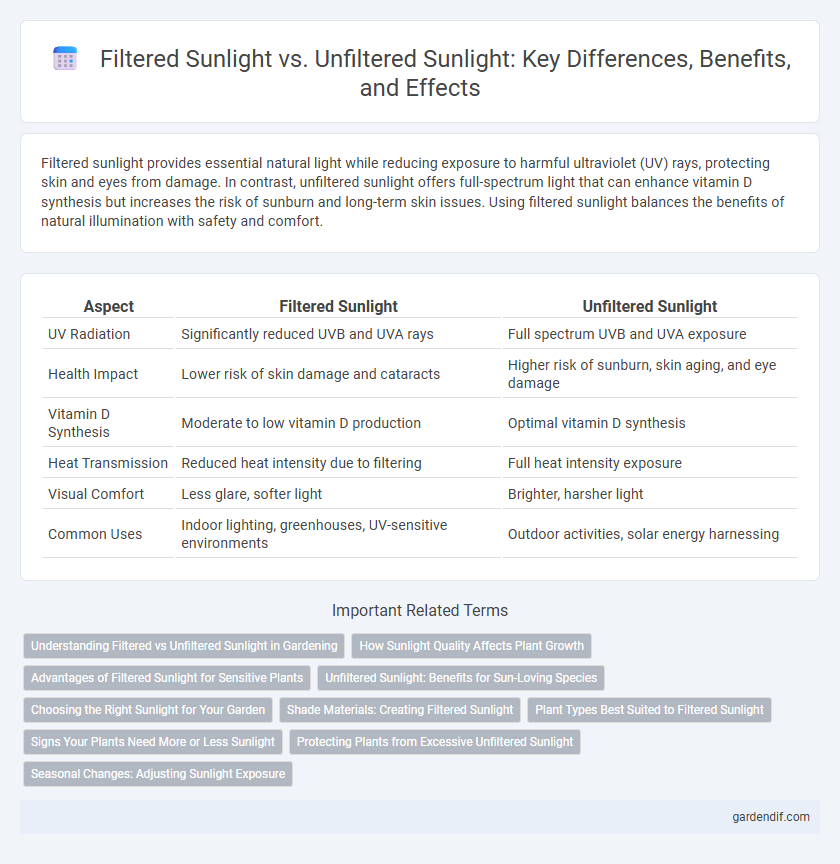
Filtered sunlight vs unfiltered sunlight Illustration
Filtered sunlight provides essential natural light while reducing exposure to harmful ultraviolet (UV) rays, protecting skin and eyes from damage. In contrast, unfiltered sunlight offers full-spectrum light that can enhance vitamin D synthesis but increases the risk of sunburn and long-term skin issues. Using filtered sunlight balances the benefits of natural illumination with safety and comfort.
Table of Comparison
| Aspect | Filtered Sunlight | Unfiltered Sunlight |
|---|---|---|
| UV Radiation | Significantly reduced UVB and UVA rays | Full spectrum UVB and UVA exposure |
| Health Impact | Lower risk of skin damage and cataracts | Higher risk of sunburn, skin aging, and eye damage |
| Vitamin D Synthesis | Moderate to low vitamin D production | Optimal vitamin D synthesis |
| Heat Transmission | Reduced heat intensity due to filtering | Full heat intensity exposure |
| Visual Comfort | Less glare, softer light | Brighter, harsher light |
| Common Uses | Indoor lighting, greenhouses, UV-sensitive environments | Outdoor activities, solar energy harnessing |
Understanding Filtered vs Unfiltered Sunlight in Gardening
Filtered sunlight provides indirect light by passing through leaves or sheer materials, reducing the intensity of UV rays and heat, which benefits shade-loving plants and prevents leaf burn. Unfiltered sunlight delivers direct exposure to the full spectrum of sunlight, essential for sun-loving plants that require high light levels for photosynthesis and growth. Understanding the differences helps gardeners optimize plant placement and health by matching specific light requirements to each species.
How Sunlight Quality Affects Plant Growth
Filtered sunlight provides plants with balanced light wavelengths, reducing harmful UV rays and intense heat that can damage delicate foliage, promoting healthier and more efficient photosynthesis. Unfiltered sunlight, while more intense, can lead to faster water loss and leaf scorching, potentially stressing plants and inhibiting optimal growth. The quality of sunlight, including its intensity and spectrum, directly influences chlorophyll production, stomatal behavior, and overall plant development.
Advantages of Filtered Sunlight for Sensitive Plants
Filtered sunlight reduces the intensity of harmful UV rays, protecting sensitive plants from leaf scorch and dehydration. It promotes optimal photosynthesis by providing a balanced light spectrum, enhancing growth and vibrant foliage. This controlled exposure minimizes stress and helps maintain delicate plant structures, improving overall health and longevity.
Unfiltered Sunlight: Benefits for Sun-Loving Species
Unfiltered sunlight delivers the full spectrum of natural light, including ultraviolet (UV) rays essential for the health of sun-loving species such as reptiles and amphibians. Exposure to unfiltered sunlight supports critical physiological processes like vitamin D3 synthesis, enhancing calcium metabolism and promoting strong bone development. This natural light source also helps regulate circadian rhythms and improves overall behavior and immune system function in these animals.
Choosing the Right Sunlight for Your Garden
Filtered sunlight, which passes through leaves or shade cloth, provides gentle, diffused light ideal for shade-loving plants like ferns, orchids, and begonias, preventing leaf burn and moisture loss. Unfiltered sunlight delivers intense, direct light crucial for sun-loving species such as tomatoes, sunflowers, and succulents, promoting robust growth and flowering. Selecting the appropriate sunlight type ensures optimal photosynthesis, plant health, and garden productivity based on species-specific light requirements.
Shade Materials: Creating Filtered Sunlight
Shade materials such as mesh fabrics, bamboo screens, and perforated metal panels create filtered sunlight by diffusing direct rays, reducing glare and UV exposure while maintaining natural light. Filtered sunlight through these materials fosters healthier plant growth and enhances outdoor comfort by balancing light intensity and temperature. Unlike unfiltered sunlight, which can cause overheating and skin damage, filtered sunlight provides a gentler, more sustainable lighting solution.
Plant Types Best Suited to Filtered Sunlight
Plants such as ferns, orchids, and African violets thrive best in filtered sunlight, which mimics their natural understory environments by providing indirect light and moderate humidity. Filtered sunlight reduces the risk of leaf burn and excessive moisture loss, making it ideal for shade-loving species that require steady, diffused light. These conditions support optimal photosynthesis and healthy growth in delicate tropical plants and shade-tolerant houseplants.
Signs Your Plants Need More or Less Sunlight
Plants displaying pale or yellowing leaves often indicate a need for more filtered sunlight to prevent leaf scorch from unfiltered, harsh rays. Wilting or browning leaf edges are common signs that unfiltered sunlight is causing stress and the plant requires less direct exposure. Adjusting the light intensity based on specific plant species' light tolerance optimizes growth and overall health.
Protecting Plants from Excessive Unfiltered Sunlight
Filtered sunlight reduces the intensity of UV rays and heat, minimizing leaf scorch and dehydration in sensitive plants. Using shade cloths or natural canopies helps maintain optimal photosynthesis while preventing excessive sun damage. Protecting plants from unfiltered sunlight enhances growth, prolongs bloom durations, and reduces stress-related diseases.
Seasonal Changes: Adjusting Sunlight Exposure
Filtered sunlight provides consistent protection from UV rays, making it beneficial during peak sunshine in summer, while unfiltered sunlight is ideal in winter months to maximize natural vitamin D absorption and warmth. Seasonal changes require adjusting exposure duration; shorter, protected intervals in summer prevent skin damage, whereas longer exposure to unfiltered sunlight in cooler seasons supports circadian rhythm regulation. Balancing filtered and unfiltered sunlight based on season enhances overall health by optimizing light intake.
Filtered sunlight vs unfiltered sunlight Infographic

 gardendif.com
gardendif.com